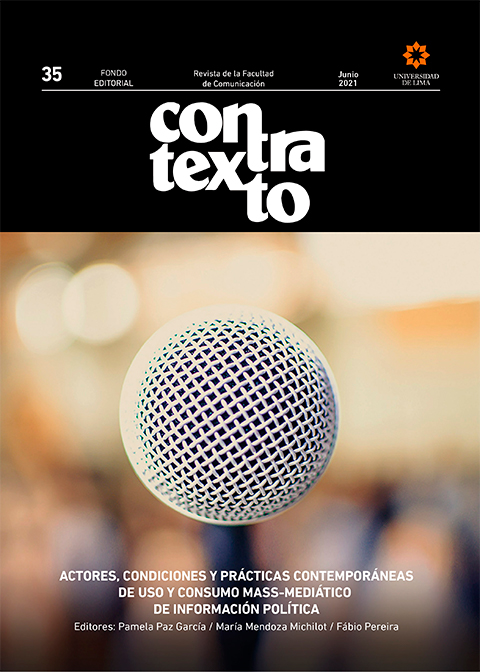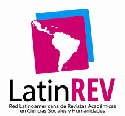Using mobile device affordances for news offering: an analysis of latin american newspaper apps
DOI:
https://doi.org/10.26439/contratexto2021.n035.4881Keywords:
mobile journalism, mobile devices, news applications, affordances, Grupos de Diarios de AméricaAbstract
This study deals with the use of mobile device affordances in news applications. It aims to identify how media groups take advantage of the devices’ native resources to offer informative content and services, such as the weather forecast. To that end, all the newspaper applications associated with the Grupo de Diarios América (GDA), an entity that gathers publications from 11 countries of the region, were analyzed. The result revealed that most newspapers take advantage of the potential provided by affordances to their applications in a residual way. Although mobile phones are the main form of Internet access in the continent, we found newspapers without an application in our sample, which portrays a still challenging scenario in the face of new mobile technologies.
Downloads
References
Bardin, L. (2010) Análise de conteúdo (4. a ed.). Lisboa: Edições 70
Bivens, R. K. (2008). The Internet, mobile phones and blogging: How new media are transforming traditional journalism. Journalism Practice, 2(1), 113-129.
Canavilhas, J., & Fidalgo, A. (2009). Todos os jornais no bolso: pensando o jornalismo na era do celular. In: Rodrigues, C. (ed.). Jornalismo Online: modos de fazer. Rio de Janeiro, Brasil: Editora Sulinas.
Canavilhas, J., & de Santana, D. C. (2016). Jornalismo para plataformas móveis de 2008 a 2011: da autonomia à emancipação, (28), pp. 53-66. Líbero.
Fidalgo, A. (2009). Pushed News: When the news comes to the cellphone. Brazilian Journalism Research, 5(2), 113-124.
Gaver, W. W. (1991, March). Technology affordances. Proceedings of the SIGCHI conference on Human factors in computing systems (pp. 79-84).
Goggin, G. (2020). Digital Journalism after Mobility. Digital Journalism, 8(1), pp. 170-173.
Habermas, J. (2016). Comunicação política na sociedade mediática: o impacto da teoria normativa na pesquisa empírica. (21), pp. 9-21.
Líbero.Luna, D., & Fante, A. (2016). O fato jornalístico narrado por meio de notificações: um olhar sobre a aplicação dos critérios de noticiabilidade na produção das pushed news. Em Canavilhas, J. e Rodrigues, C. (orgs.). Jornalismo móvel: linguagem, género e modelos de negócios (pp. 175-196). Covilhã: LabCom,
Mielkniczuk, L., & Barbosa, S. (2005). Digital journalism: democratizing social memory. Brazilian Journalism Research, 1(2), 65-80.
Moretzsohn, S. (2002). Jornalismo em” tempo real”: o fetiche da velocidade. Rio de Janeiro: Editora Revan.
Palacios, M. S., & Cunha, R. (2012). A tactilidade em dispositivos móveis: primeiras reflexões e ensaio de tipologias. Contemporânea, 10(3), 668-685.
Palacios, M., Barbosa, S., Silva, F. F., & Cunha, R. (2015). Jornalismo móvel e inovações induzidas por affordances em narrativas para aplicativos em tablets e smartphones. Em Canavilhas, J. e Satuf, I. (orgs.). Jornalismo para dispositivos móveis: produção, distribuição e consumo (pp. 7-42). Covilhã: Livros LabCom.
Pavlik, J. V. (2020). Ciberjornalismo: muito mais do que notícias no formato digital. Esferas, (17).
Rublescki, A. S. (2011). Jornalismo líquido: mediação multinível e notícias em fluxos. (Tese de Doutoramento) Universidade Federal do Rio Grande do Sul, Rio Grande do Sul, Brasil.
Salaverría, R. (2016). Ciberperiodismo en Iberoamérica. Madrid: Nuevo libro.
Silva. F.F. (2013). Jornalismo móvel digital: uso das tecnologias móveis digitais e a reconfguração das rotinas de produção da reportagem de campo. (Tese de Doutoramento) Universidade Federal da Bahia, Salvador, Brasil.
Silva, F. F. (2015). Jornalismo móvel. Salvador: Edufba.
Westlund, O. (2013). Mobile news: A review and model of journalism in an age of mobile media. Digital journalism, 1(1), 6-26.
Downloads
Published
Issue
Section
License
All of the works published are licensed under a CC BY 4.0 Creative Commons Attribution license. (updated on March 1st 2021)
The content of the journal may be shared in any material or format. The content may be adapted, contributed upon and transformed. Both possibilities are only permitted in so far as they complete the following conditions:
- Attribution: Credit must be given where it is due, a link to the license must be provided and changes, if made, must be indicated. This should be done in the manner deemed appropriate, without suggesting that the licensor promotes you or your use of the material.
Ownership rights
The patrimonial rights for Contratexto are published under a Creative Commons BY 4.0 license, allowing authors to keep the patrimonial rights to their work without restrictions.
If a work published in Contratexto were to be copied, distributed, spread, or any other activities contemplated in the aforementioned license, the author(s) and the journal must be mentioned visibly and expressly.
Self-archive
This journal allows and encourages authors to post items submitted to the journal on personal websites or institutional repositories both prior to and after publication, while providing bibliographic details that credit, if applicable, its publication in this journal.

















